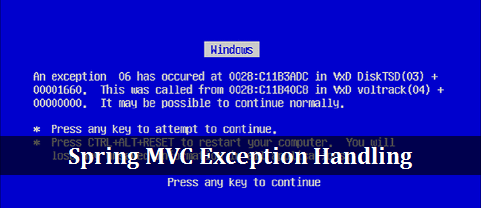
Spring MVC provides a great way to handle exceptions and errors. @ExceptionHandler annotation is core to this feature. For each Spring controller we can simply define a method that automatically gets called if a given exception occurs. For example:
import org.springframework.web.bind.annotation.ExceptionHandler;
//..
@ExceptionHandler(IOException.class)
public String exception(Exception e) {
//..
return "error";
}Code language: Java (java)Thus whenever an IOException is raised from any controller method will call the above method exception(). We mapped IOException.class to this method using @ExceptionHandler annotation.
One short coming of this annotation is that it only handles exception getting raised from the controller where it is defined. It will not handle exceptions getting raised from other controllers. However this is a way to overcome this problem. @ControllerAdvice annotation is at your service for that.
@ControllerAdvice annotation
This annotation is used to define @ExceptionHandler, @InitBinder, and @ModelAttribute methods that apply to all @RequestMapping methods.
import org.springframework.web.bind.annotation.ControllerAdvice;
//..
@ControllerAdvice
public class ExceptionControllerAdvice {
@ExceptionHandler(Exception.class)
public String exception(Exception e) {
return "error";
}
}Code language: Java (java)Thus if we define our @ExceptionHandler annotation on method in @ControllerAdvice class, it will be applied to all the controllers.
One thing worth noting here is that Spring configuration must define mvc namespace in order to identify @ControllerAdvice annotation. Thus you must define following in your spring-servlet.xml file.
<mvc:annotation-driven/>Code language: HTML, XML (xml)If you have defined just the <context:annotation-config /> it wouldn’t work. The @ControllerAdvice will simply wont be loaded. So always remember to use <mvc:annotation-driven/> in Spring configuration.
Let us check a complete tutorial.
Complete Tutorial
Now we know the concept, let us use it and create a Spring MVC based application to track page hits. We will use Cookie to track page hit counter.
For this tutorial I will be using following tools and technologies:
- Spring MVC 3.2.6.RELEASE
- Java 6
- Eclipse
- Maven 3
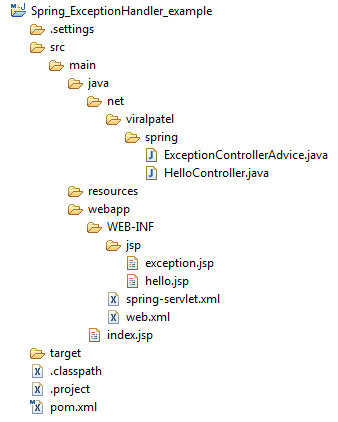
Following is the project structure.
Create and copy following file contents in the project structure.
Maven configuration: pom.xml
<project xmlns="http://maven.apache.org/POM/4.0.0" xmlns:xsi="http://www.w3.org/2001/XMLSchema-instance"
xsi:schemaLocation="http://maven.apache.org/POM/4.0.0 http://maven.apache.org/maven-v4_0_0.xsd">
<modelVersion>4.0.0</modelVersion>
<groupId>net.viralpatel.spring</groupId>
<artifactId>Spring_ExceptionHandler_example</artifactId>
<packaging>war</packaging>
<version>1.0.0-SNAPSHOT</version>
<name>Spring_ExceptionHandler_example</name>
<properties>
<org.springframework.version>3.2.6.RELEASE</org.springframework.version>
<project.build.sourceEncoding>UTF-8</project.build.sourceEncoding>
<compileSource>1.6</compileSource>
</properties>
<dependencies>
<dependency>
<groupId>javax.servlet</groupId>
<artifactId>servlet-api</artifactId>
<version>2.5</version>
<scope>provided</scope>
</dependency>
<!-- Spring MVC -->
<dependency>
<groupId>org.springframework</groupId>
<artifactId>spring-web</artifactId>
<version>${org.springframework.version}</version>
</dependency>
<dependency>
<groupId>org.springframework</groupId>
<artifactId>spring-webmvc</artifactId>
<version>${org.springframework.version}</version>
</dependency>
<!-- JSTL taglib -->
<dependency>
<groupId>taglibs</groupId>
<artifactId>standard</artifactId>
<version>1.1.2</version>
</dependency>
<dependency>
<groupId>javax.servlet</groupId>
<artifactId>jstl</artifactId>
<version>1.1.2</version>
</dependency>
</dependencies>
<build>
<finalName>Spring_ExceptionHandler_example</finalName>
</build>
<profiles>
</profiles>
</project>Code language: HTML, XML (xml)Maven configuration is simple. We just need Spring MVC and JSTL dependency.
Deployment description: web.xml
<?xml version="1.0" encoding="UTF-8"?>
<web-app xmlns:xsi="http://www.w3.org/2001/XMLSchema-instance"
xmlns="http://java.sun.com/xml/ns/javaee" xmlns:web="http://java.sun.com/xml/ns/javaee/web-app_2_5.xsd"
xsi:schemaLocation="http://java.sun.com/xml/ns/javaee http://java.sun.com/xml/ns/javaee/web-app_2_5.xsd"
id="WebApp_ID" version="2.5">
<display-name>Spring MVC Http Cookie</display-name>
<welcome-file-list>
<welcome-file>hello.htm</welcome-file>
</welcome-file-list>
<servlet>
<servlet-name>spring</servlet-name>
<servlet-class>org.springframework.web.servlet.DispatcherServlet</servlet-class>
<load-on-startup>1</load-on-startup>
</servlet>
<servlet-mapping>
<servlet-name>spring</servlet-name>
<url-pattern>*.htm</url-pattern>
</servlet-mapping>
</web-app>Code language: HTML, XML (xml)Web.xml is quite simple too. We just need to configure Spring’s DispatcherServlet with *.htm url pattern.
Spring configuration: spring-servlet.xml
<?xml version="1.0" encoding="UTF-8"?>
<beans xmlns="http://www.springframework.org/schema/beans"
xmlns:xsi="http://www.w3.org/2001/XMLSchema-instance"
xmlns:context="http://www.springframework.org/schema/context"
xmlns:mvc="http://www.springframework.org/schema/mvc"
xsi:schemaLocation="http://www.springframework.org/schema/beans http://www.springframework.org/schema/beans/spring-beans.xsd
http://www.springframework.org/schema/context http://www.springframework.org/schema/context/spring-context.xsd
http://www.springframework.org/schema/mvc http://www.springframework.org/schema/mvc/spring-mvc.xsd">
<mvc:annotation-driven/>
<context:component-scan base-package="net.viralpatel" />
<bean id="viewResolver"
class="org.springframework.web.servlet.view.InternalResourceViewResolver">
<property name="viewClass"
value="org.springframework.web.servlet.view.JstlView" />
<property name="prefix" value="/WEB-INF/jsp/" />
<property name="suffix" value=".jsp" />
</bean>
</beans>Code language: HTML, XML (xml)In spring-servlet.xml we just defined component scan to load @Controller classes. Also we defined a view resolver that will points to JSPs within /WEB-INF/jsp/ folder. As noted earlier, we defined <mvc:annotation-driven/> to load @ControllerAdvice classes.
Spring Controller
We will define one spring controller and one @ControllerAdvice class for this example. One is just to render a hello page with a link. On click of the link we invoke another controller method. This method however will throw an exception.
HelloController.java
package net.viralpatel.spring;
import java.io.IOException;
import org.springframework.stereotype.Controller;
import org.springframework.web.bind.annotation.RequestMapping;
@Controller
public class HelloController {
@RequestMapping(value = "/hello.htm")
public String hello() throws IOException {
// render hello.jsp page
return "hello";
}
@RequestMapping(value = "/test.htm")
public String test() throws IOException {
//just throw exception to test the exceptionhandler mapping
if(true) {
throw new IOException("this is io exception");
}
// render hello.jsp page
return "hello";
}
}Code language: Java (java)ExceptionControllerAdvice.java
package net.viralpatel.spring;
import org.springframework.web.bind.annotation.ControllerAdvice;
import org.springframework.web.bind.annotation.ExceptionHandler;
import org.springframework.web.servlet.ModelAndView;
@ControllerAdvice
public class ExceptionControllerAdvice {
@ExceptionHandler(Exception.class)
public ModelAndView exception(Exception e) {
ModelAndView mav = new ModelAndView("exception");
mav.addObject("name", e.getClass().getSimpleName());
mav.addObject("message", e.getMessage());
return mav;
}
}Code language: Java (java)This class simply define a @ControllerAdvice and a method with @ExceptionHandler. This method will be called whenever an unhandled exception occurs.
JSP views
Two JSPs will be used. One for hello page and one which will be called in case of any error.
hello.jsp
<html>
<head>
<title>Spring MVC Exception Handling</title>
</head>
<body>
<h1>Spring MVC Exception Handling</h1>
<a href="test.htm">Click here to test Exception handling</a>
</body>
</html>Code language: HTML, XML (xml)exception.jsp
<html>
<head>
<title>Spring MVC @ControllerAdvice example</title>
</head>
<body>
<h1>Ops! Something went wrong</h1>
<b>${name}</b>: ${message}
</body>
</html>Code language: HTML, XML (xml)Demo
Compile and run the project. Open your favorite web browser and point to below URL:
http://localhost:8080/Spring_ExceptionHandler_example/hello.htm
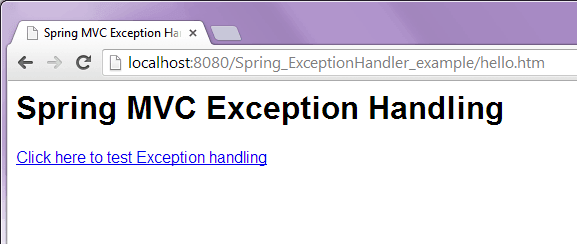
Once you click the link, the controller throws an exception which is handled nicely by @ExecptionHandler method.
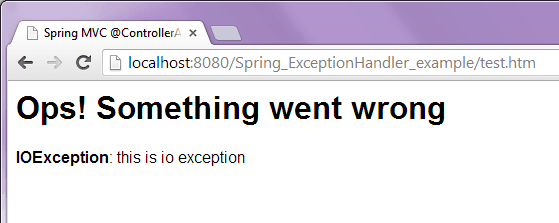
Download Source Code
Spring_ExceptionHandler_example.zip (10 KB)
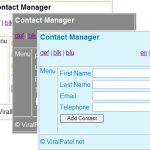
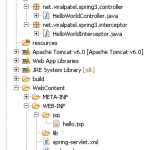
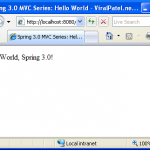
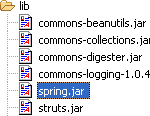
Hi,
Thanks for writing this tutorial.
I am getting below exception while running my spring application, can guide me if i am doing anything wrong.
org.xml.sax.SAXParseException: cos-all-limited.1.2: An ”all” model group must appear in a particle with ‘{‘min occurs’}’='{‘max occurs’}’=1, and that particle must be part of a pair which constitutes the ‘{‘content type’}’ of a complex type definition.
at org.apache.xerces.parsers.DOMParser.parse(DOMParser.java:267)
at org.apache.xerces.jaxp.DocumentBuilderImpl.parse(DocumentBuilderImpl.java:201)
=====================
below is my config file
Nicely complements this other useful blog post: http://spring.io/blog/2013/11/01/exception-handling-in-spring-mvc
Hi,
I have done the setup but unfortunately my @ControllerAdvice Class is not handling the exceptions.
I have a similar situation like below link.
http://stackoverflow.com/questions/21884737/controlleradvice-not-firing
Any help would be appreciated.
please post a clear example on freemarker+springMVC with freemarker TemplateExceptionHandler.
How to catch TemplateException raised in freemarker???
Hi,
Nice example, Can i forward the exception message to the same jsp page instead of a seperate exception page ? If it is possible please let me know the way to do it.
Thanks
thx, this blog is quite useful for me.
thx again
Thanks Irving..
thanks. very useful post…
but 404(File Not Found) error is not rendered to the exception JSP file…